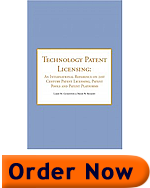[Summary of Chapter 2]:
Three kinds of patent licensing are described, which are (1) traditional bilateral licensing; (2) aggregated licensing through a patent pool; and (3) aggregated licensing through a patent platform. These three methods of licensing are compared by various criteria, including their respective characters, the ways in which essentiality to a standard are evaluated, various terms & conditions in licensing contracts, scopes of product coverage, costs, and situations in which the different methods are most suited. A prediction is made that while traditional bilateral licensing will always remain important, over time aggregated licensing (such as the patent pool and the platform) will become more important as a way to cope with the problem of fragmented patent ownership.
=\=\=\=\=\=\=\=\=\=\=\=\=\=\=\=\=
[Brief Excerpt from Chapter 2, pp.66-67]:
Knowledge-based industries will play in increasingly important role in creating economic activity and in generating wealth in the developed and developing nations. In parallel with this trend, the strategic and tactical usage of IPR [intellectual property rights] will continue unabated. A key element in the management and exploitation of IPR is patent licensing. In this chapter, we explore the various patent licensing options available for use in the knowledge-based industries…We will make a direct comparison among the three types of licensing. With this basis, we will then outline in broad terms the history of licensing, from a simpler past to a more varied future.
To Continue To Chapter 3 –Click Here.
